1993 CHEVROLET BLAZER service schedule
[x] Cancel search: service schedulePage 353 of 386
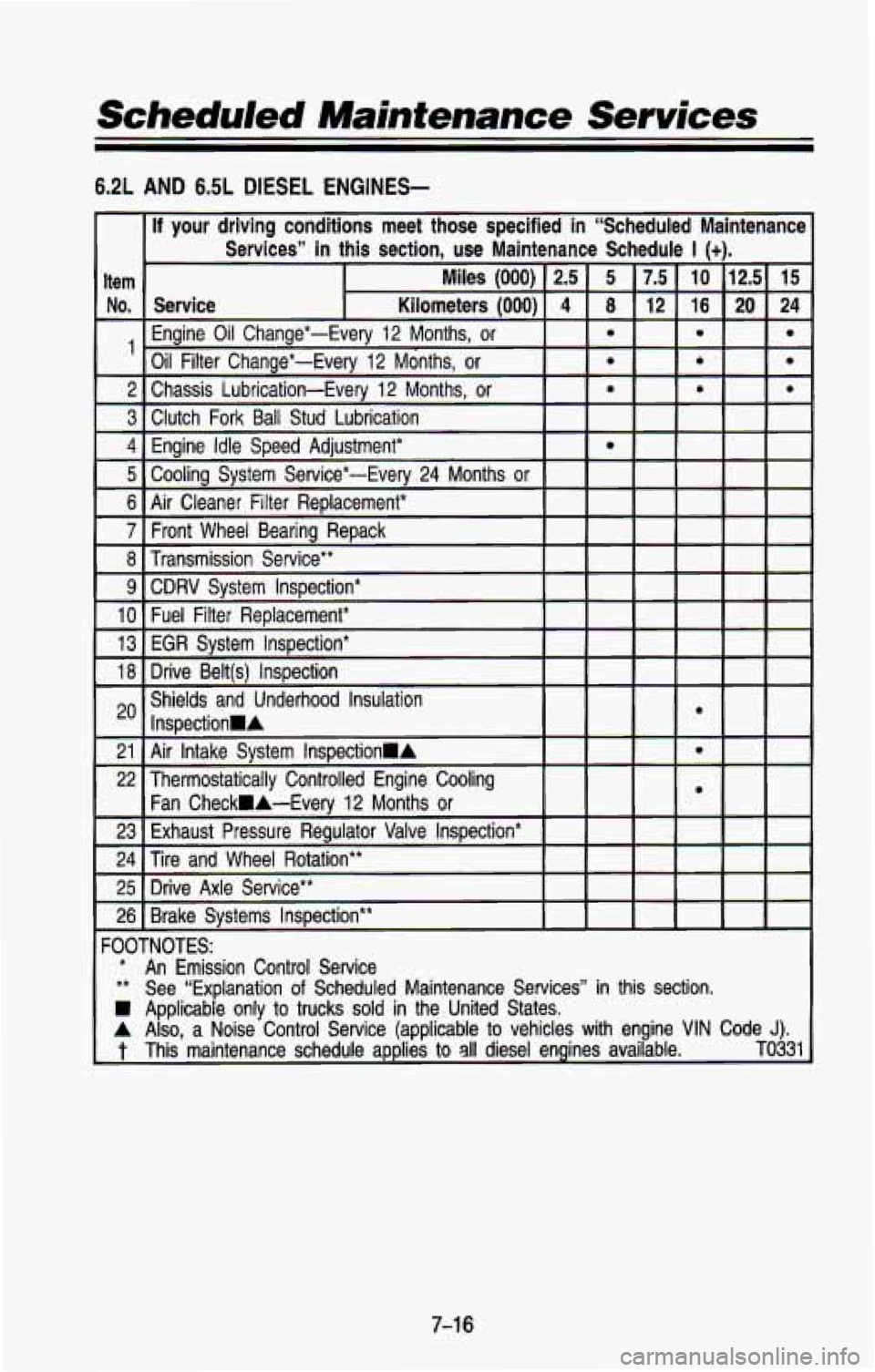
Scheduled Maintenance Services
6.2L AND 6.5L DIESEL ENGINES-
-0OTNOTES:
* An Emission Control Service
** See “Explanation of Scheduled Maintenance Services” in this section.
W Applicable only to trucks sold in the United States.
A Also, a Noise Control Service (applicable to vehicles with engine VIN Code J).
t This maintenance schedule applies to sll diesel engines available. TO33 1
7-1 6
Page 354 of 386
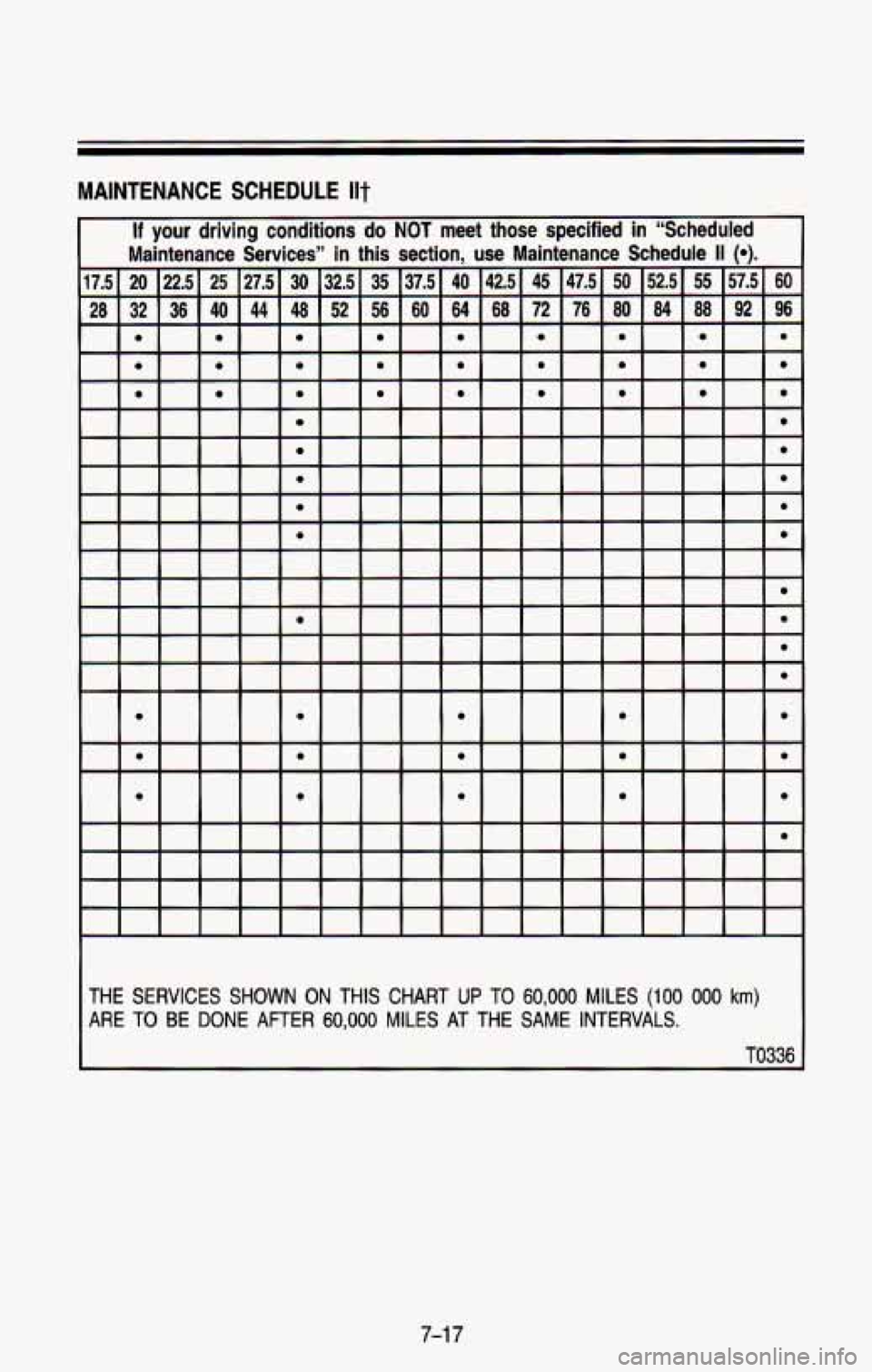
MAINTENANCE SCHEDULE Ilt
If your driving conditions do NOT meet those specified in “Scheduled
Maintenance Services” in this section, use Maintenance Schedul\
e
II (0).
THE SERVICES SHOWN ON THIS CHART UP TO 60,000 MILES (100 000 km)
ARE TO BE DONE AFTER 60,000 MILES AT THE SAME INTERVALS.
TO336
7-1 7
Page 355 of 386

Scheduled Maintenance Services
Explanation Of Scheduled Maintenance Services
Below are explanations of the services listed in the maintenance charts.
The proper fluids and lubricants to use are listed in this section. Make sure
whoever services your vehicle uses these.
All parts should be replaced and
all necessary repairs done before you or anyone else drives the ve\
hicle.
1. ENGINE OIL AND OIL FILTER CHANGE* -ALWAYS USE SG OR
SG/CE QUALITY, ENERGY CONSERVING II OILS OF THE PROPER
VISCOSITY. To determine the preferred viscosity oil for your vehicle’s
engine (e.g. SAE 5W-30 or
10W-30), see “Engine Oil” in the Index.
2. CHASSIS LUBRICATION -Lubricate the front suspension, king pin
bushings, steering linkage, transmission, and transfer case shift\
linkage,
parking brake cable guides, propshaft splines
(2 wheel drive), brake
pedal springs, and clutch pedal springs at the intervals specif\
ied.
If you have a 3500 HD, lubricate the king pins and king pin bushings
every
1,500 miles (2500 km) for Maintenance Schedule 1, or every 3,000
(5000 km) for Maintenance Schedule 2.
Ball joints and king pin bushings should not be lubricated unl\
ess their
temperature is
10°F (-12”C), or higher. When the weather is cold, let
them warm up before lubrication
or they could be damaged.
Also, be sure to check all the vehicle fluid levels at this time.
3.
CLUTCH FORK BALL STUD LUBRICATION -Lubricate the clutch fork
ball stud through the fitting on the clutch housing. Lubricant \
must be
added “sparingly” to the fitting, as only.
0066 Ib. (.003 kg) is required to
lubricate the ball stud surface. Do not add lubricant more often than the
intervals in the Maintenance Charts.
Too much lubricant will damage
the clutch
assembly.
4. ENGINE IDLE SPEED ADJUSTMENT (DIESEL ENGINES)* -Adjust to
the specifications shown on the underhood label. You must use
calibrated test equipment.
5. COOLING SYSTEM SERVICE* -Drain, flush and refill system with new
coolant. See “Engine Coolant” in the Index for the proper\
coolant and
mixture
to use in your vehicle.
Also inspect the hoses and replace them if they i cracked, swollen, or
deteriorated. Tighten all hose clamps (except consrant tension clamps).
Remove debris and clean the outside of the radiator and air c\
onditioning
condenser. Wash the radiator neck.
To ensure proper operation, pressure
test the radiator and cap.
* An Emission Control Service
7-1 8
Page 357 of 386
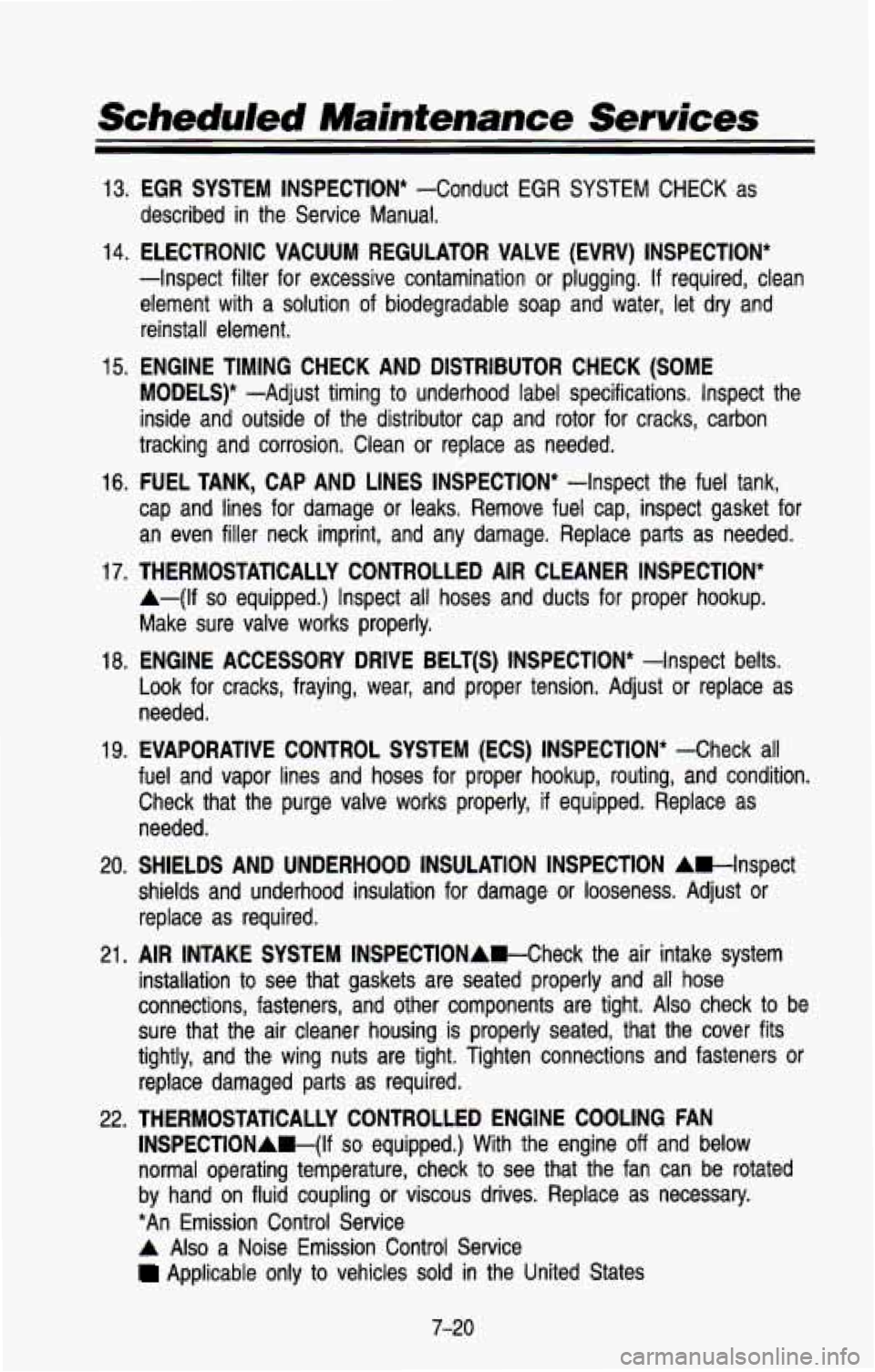
Scheduled Maintenance Services
13. EGR SYSTEM INSPECTION* -Conduct EGR SYSl /l CHECK as
described in the Service Manual.
14. ELECTRONIC VACUUM REGULATOR VALVE (EVRV) INSPECTION*
-Inspect filter for excessive contamination or plugging. If required, clean
element with a solution of biodegradable soap and water, let
dry and
reinstall element.
MODELS)* -Adjust timing to underhood label specifications. Inspect the
inside and outside of the distributor cap and rotor for cracks, carbon
tracking and corrosion. Clean or replace as needed.
15. ENGINE TIMING CHECK AND DISTRIBUTOR CHECK (SOME
16. FUEL TANK, CAP AND LINES INSPECTION* -Inspect the fuel tank,
cap and lines
for damage or leaks. Remove fuel cap, inspect gasket for
an even filler neck imprint, and any damage, Replace parts as needed.
17.
THERMOSTATICALLY CONTROLLED AIR CLEANER INSPECTION*
A-(If so equipped.) Inspect all hoses and ducts for proper hookup.
Make sure valve works properly.
Look for cracks, fraying, wear, and proper tension. Adjust or replace as
needed.
19. EVAPORATIVE CONTROL SYSTEM (ECS) INSPECTION* -Check all
fuel and vapor lines and hoses for proper hookup, routing, and\
condition.
Check that the purge valve works properly, if equipped. Replace\
as needed.
20.
SHIELDS AND UNDERHOOD INSULATION INSPECTION Awlnspect
shields and underhood insulation for damage or looseness. Adjust
or
replace as required.
installation to see that gaskets are seated properly and all hose
connections, fasteners, and other components are tight.
Also check to be
sure that the air cleaner housing is properly seated, that the\
cover
fits
tightly, and the wing nuts are tight. Tighten connections and \
fasteners or
replace damaged parts as required.
18. ENGINE ACCESSORY DRIVE BELT(S) INSPECTION* --Inspect belts.
21.
AIR INTAKE SYSTEM INSPECTlONAWCheck the air intake system
22. THERMOSTATICALLY CONTROLLED ENGINE COOLING FAN INSPECTIONAB-(If
so equipped.) With the engine off and below
normal operating temperature, check
to see that the fan can be rotated
by hand on fluid coupling or viscous drives. Replace as necessary.
*An Emission Control Service
A Also a Noise Emission Control Service
Applicable only to vehicles sold in the United States
7-20
Page 358 of 386
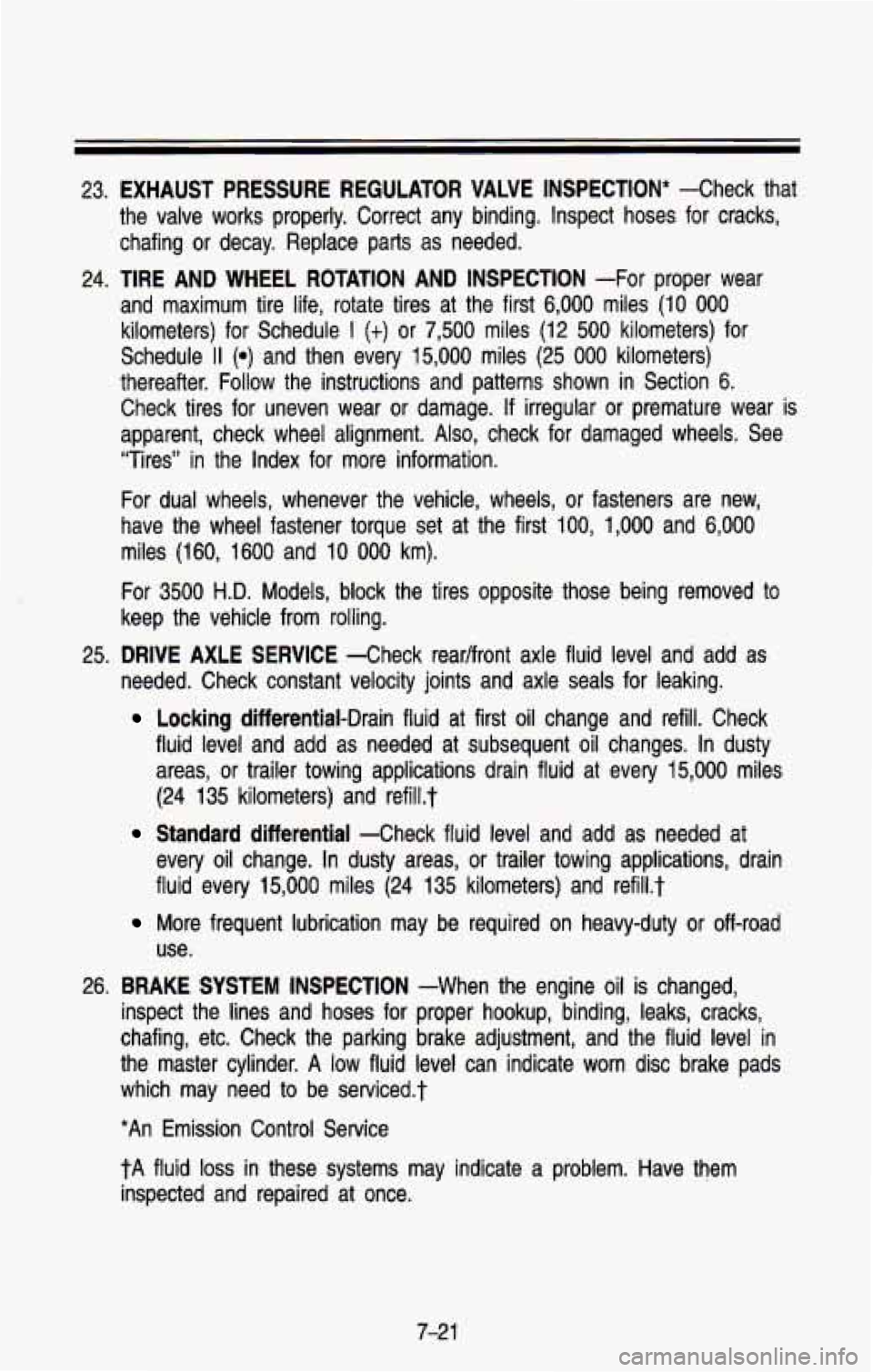
23. EXHAUST PRESSURE EGULATOR VALVE INSPECTION* -Check that
the valve works properly. Correct any binding. Inspect hoses fo\
r cracks,
chafing or decay. Replace parts
as needed.
24. TIRE AND WHEEL ROTATION AND INSPECTION -For proper wear
and maximum tire life, rotate tires
at the first 6,000 miles (10 000
kilometers) for Schedule I (t) or 7,500 miles (12 500 kilometers) for
Schedule
II (.) and then every 15,000 miles (25 000 kilometers)
thereafter.
Follow the instructions and patterns shown in Section 6.
Check tires for uneven wear or damage. If irregular or premature wear is
apparent, check wheel alignment.
Also, check for damaged wheels. See
“Tires” in the Index for more information.
For dual wheels, whenever the vehicle, wheels, or fasteners are new\
,
have the wheel fastener torque set at the first 100,
1,000 and 6,000
miles
(160, 1600 and 10 000 km).
For
3500 H.D. Models, block the tires opposite those being removed to
keep the vehicle from rolling.
25.
DRIVE AXLE SERVICE -Check readfront axle fluid level and add as
needed. Check constant velocity joints and axle seals for leaki\
ng.
Locking differential-Drain fluid at first oil change and refill. Check
fluid level and add as needed at subsequent oil changes. In dusty
areas, or trailer towing applications drain fluid at every
15,000 miles
(24 135 kilometers) and refill$
every oil change. In dusty areas,
or trailer towing applications, drain
fluid every 15,000 miles
(24 135 kilometers) and refi1l.t
Standard differential -Check fluid level and add as needed at
More frequent lubrication may be required on heavy-duty or off-road
use.
26. BRAKE SYSTEM INSPECTION -When the engine oil is changed,
inspect the lines
and hoses for proper hookup, binding, leaks, cracks,
chafing, etc. Check the parking brake adjustment, and the fluid level in
the master cylinder.
A low fluid level can indicate worn disc brake pads
which may need to be serviced$
*An Emission Control Service
tA fluid loss in these systems may indicate a problem. Have them
inspected and repaired
at once.
7-2 1
Page 359 of 386
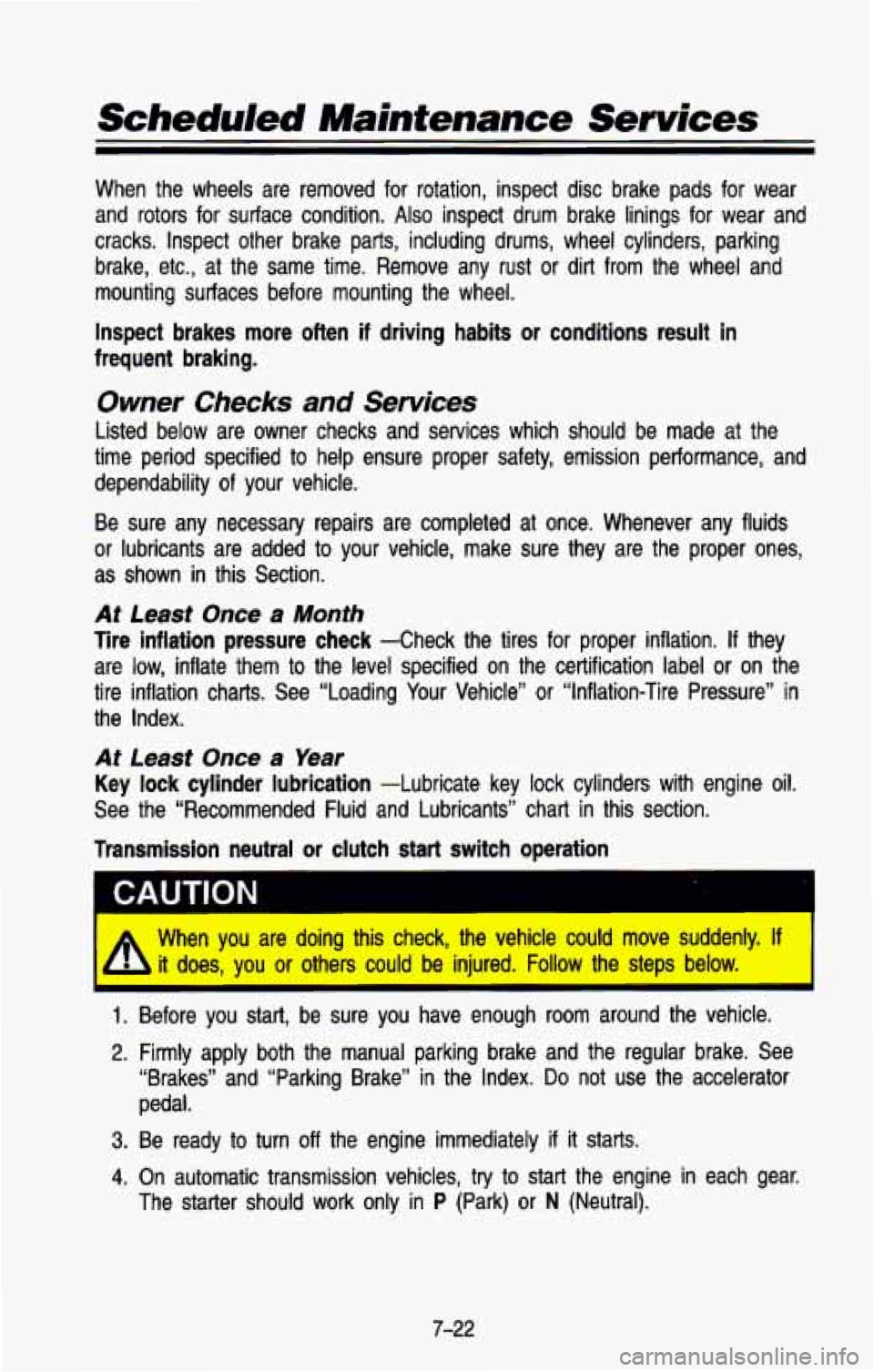
Scheduled Maintenance Services
When the wheels are removed for rotation, inspect disc brake p\
ads for wear
and rotors for surface condition.
Also inspect drum brake linings for wear and
cracks. Inspect other brake parts, including drums, wheel cylind\
ers, parking
brake, etc., at the same time. Remove any rust
or dirt from the wheel and
mounting surfaces before mounting the wheel.
Inspect brakes more often if driving habits or conditions result in
frequent braking.
Owner Checks and Services
Listed below are owner checks and services which should be made at the
time period specified to help ensure proper safety, emission pe\
rformance, and
dependability of your vehicle.
Be sure any necessary repairs are completed at once. Whenever \
any fluids
or lubricants are added to your vehicle, make sure they are the proper ones,
as shown in this Section.
At Least Once a Month
Tire inflation pressure check --Check the tires for proper inflation. If they
are low, inflate them to the level specified on the certification label
or on the
tire inflation charts. See “Loading Your Vehicle” or “Inflation-Tire Pressure” in
the Index.
At Least Once a Year
Key lock cylinder lubrication --Lubricate key lock cylinders with engine oil.
See the “Recommended Fluid and Lubricants” chart in this section.
Transmission neutral or clutch start switch operation
4 When you are doing this check, the vehicle could move suddenly. If
it does, you or others could be injured. Follow the steps below. I
1. Before you start, be sure you have enough room around the veh\
icle.
2. Firmly apply both the manual parking brake and the regular bra\
ke. See
“Brakes” and “Parking Brake” in the Index.
Do not use the accelerator
pedal.
3. Be ready to turn off the engine immediately if it starts.
4. On automatic transmission vehicles, try to start the engine in each gear.
The starter should work only in
P (Park) or N (Neutral).
7-22
Page 361 of 386
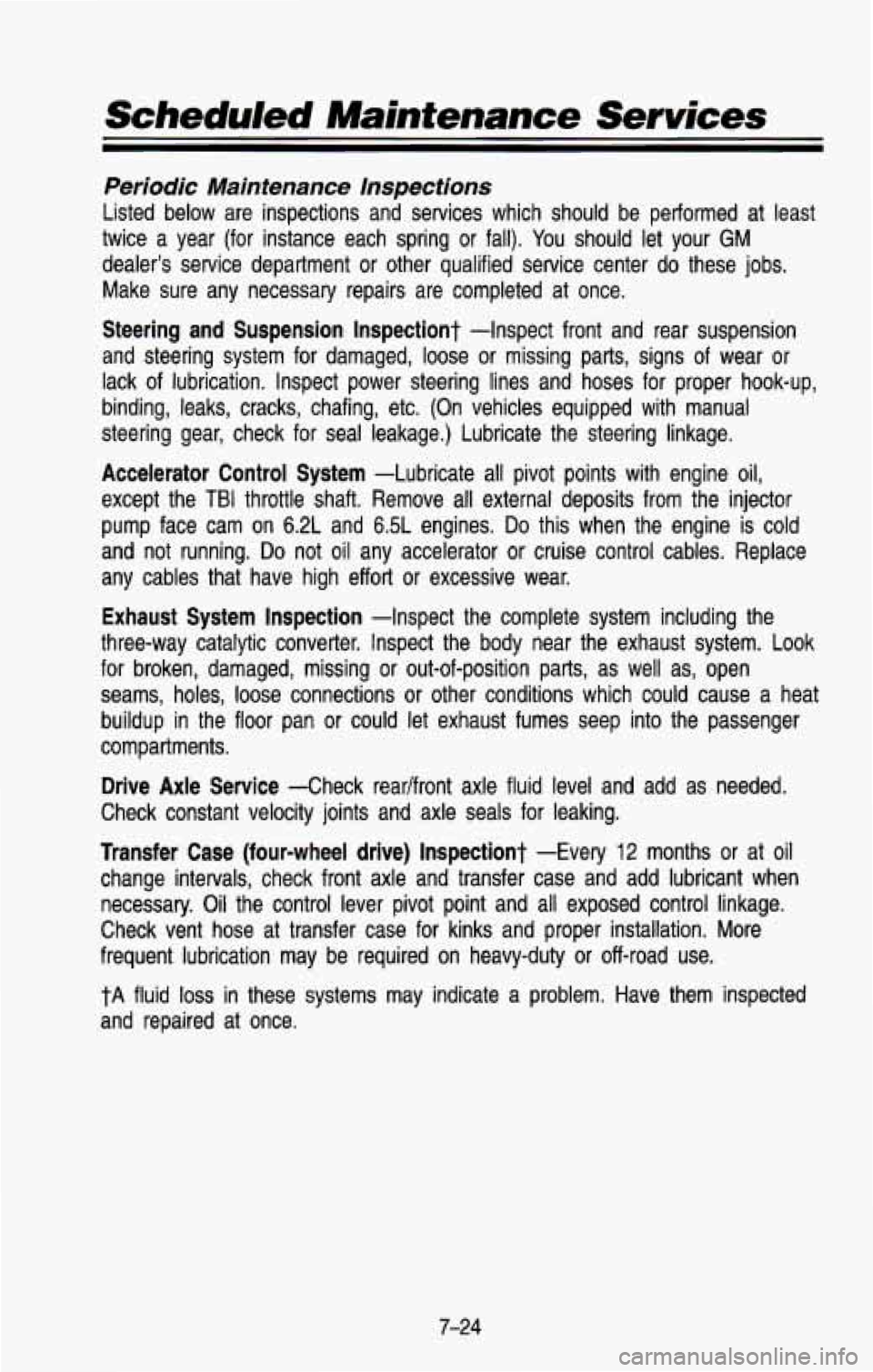
Scheduled Maintenance Services
Periodic Maintenance Inspections
Listed below are inspections and services which should be performed at least
twice a year (for instance each spring or fall). You should let your GM
dealer’s service department or other qualified service center
do these jobs.
Make sure any necessary repairs are completed at once.
Steering and Suspension lnspectiont -Inspect front and rear suspension
and steering system
for damaged, loose or missing parts, signs of wear or
lack of lubrication. Inspect power steering lines and hoses for\
proper hook-up,
binding, leaks, cracks, chafing, etc. (On vehicles equipped wit\
h manual
steering gear, check for seal leakage.) Lubricate the steering linkage.
Accelerator Control System -Lubricate all pivot points with engine oil,
except the
TBI throttle shaft. Remove all external deposits from the injector
pump face cam on 6.2L and 6.5L engines.
Do this when the engine is cold
and not running.
Do not oil any accelerator or cruise control cables. Replace
any cables that have high effort
or excessive wear.
Exhaust System Inspection -Inspect the complete system including the
three-way catalytic converter. Inspect the body near the exhaust system. Look
for broken, damaged, missing
or out-of-position parts, as well as, open
seams, holes, loose connections
or other conditions which could cause a heat
buildup in the
floor pan or could let exhaust fumes seep into the passenger
compartments.
Drive Axle Service -Check readfront axle fluid level and add as needed.
Check constant velocity joints and axle seals for leaking.
Transfer Case (four-wheel drive) lnspectiont -Every 12 months or at oil
change intervals, check front axle and transfer case and add l\
ubricant when
necessary. Oil the control lever pivot point and all exposed control linkage. \
Check vent hose at transfer case for kinks and proper installa\
tion. More
frequent lubrication may be required on heavy-duty
or off-road use.
tA fluid loss in these systems may indicate a problem. Have them inspected
and repaired at once.
7-24
Page 363 of 386
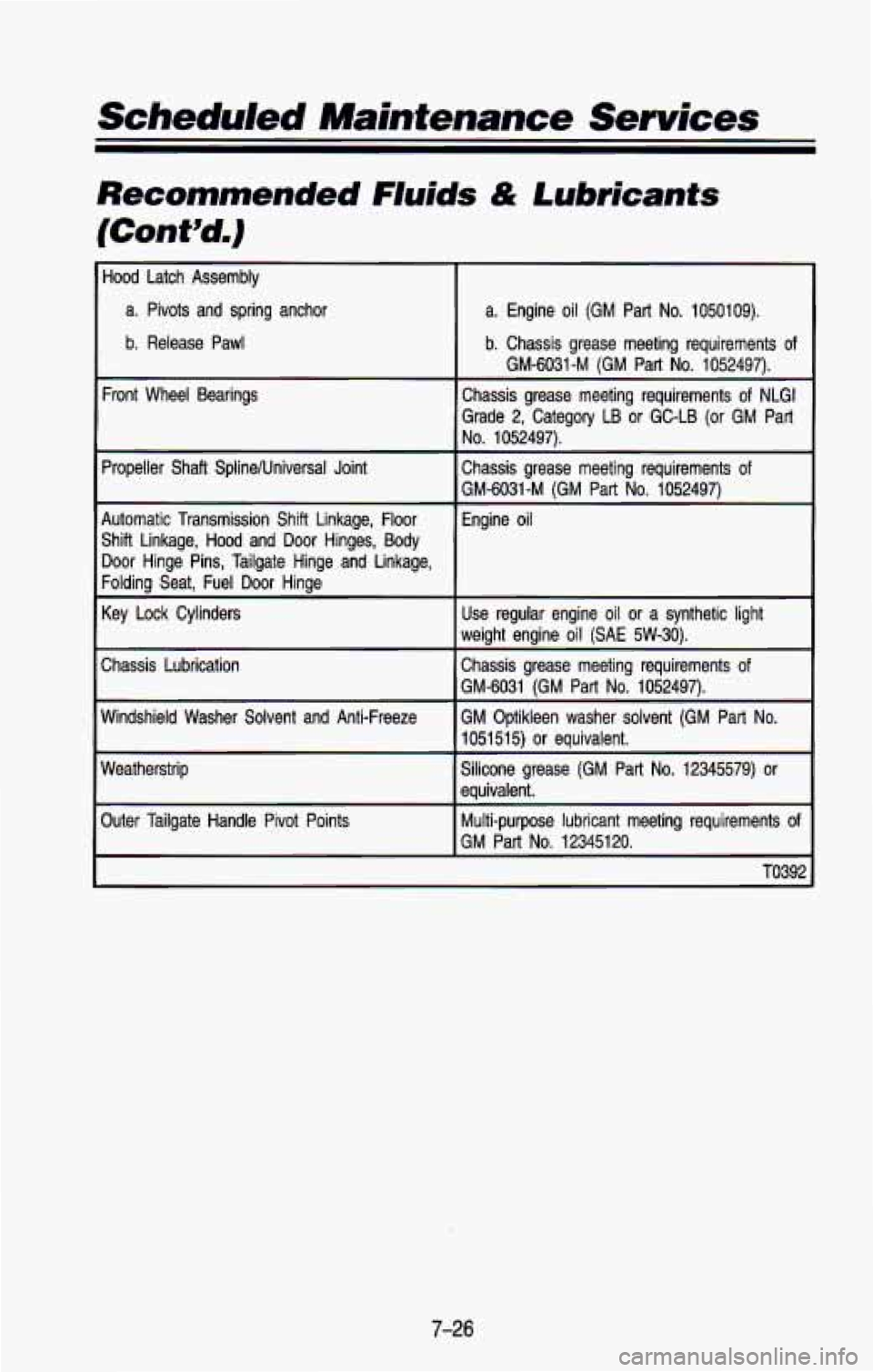
Scheduled Maintenance Services
Recommended Fluids & Lubricants
(Cont’d.)
Hood Latch Assembly
a. Pivots and spring anchor b. Release Pawl
Front Wheel Bearings
Propeller
Shaft SplinelUniversal Joint
Automatic Transmission Shift Linkage, Floor
Shift Linkage,
Hood and Door Hinges, Body
Door Hinge Pins, Tailgate Hinge and Linkage,
Folding Seat, Fuel Door Hinae Key Lock Cylinders
Chassis Lubrication
Nindshield Washer Solvent and Anti-Freeze
Neatherstrip
Mer Tailgate Handle Pivot Points a. Engine
oil (GM Part
No. 1050109).
b. Chassis grease meeting requirements
of
GM-6031-M (GM Part No. 1052497).
Chassis grease meeting requirements
of NLGl
Grade 2, Category
LB or GC-LB (or GM Part
No. 1052497).
Chassis grease meeting requirements
of
GM-6031-M EM Part No. 10524971
Engine oil
Use regular engine
oil or a synthetic light
weiaht enaine
oil [SAE 5W-30).
Chassis grease meeting requirements
of
GM-6031 (GM Part No. 1052497).
GM Optikleen washer solvent
(GM Part No.
1051515) or equivalent.
Silicone grease
(GM Part No. 12345579) or
equivalent.
Multi-purpose lubricant meeting requirements
of
GM Part No. 123451 20.
TO392
7-26